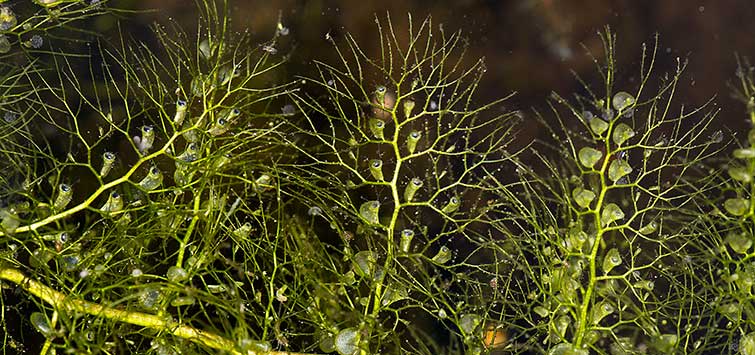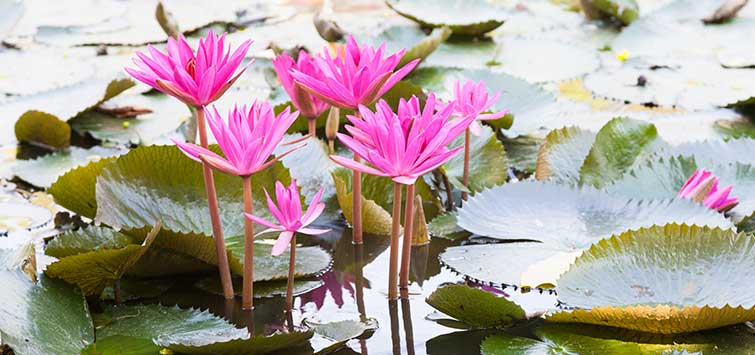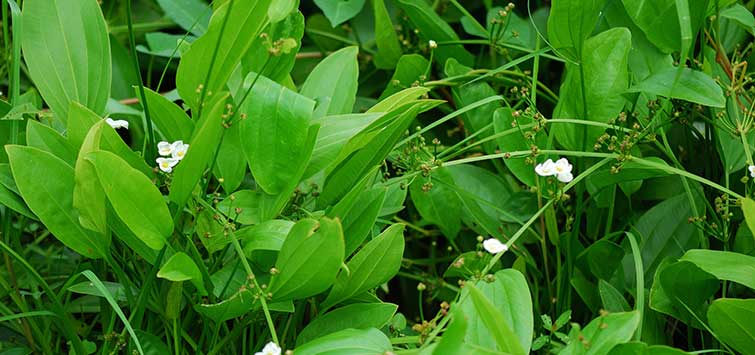Plants That Bite Back: Keeping Carnivorous Plants
Author: Joshua Wiegert
Carnivorous plants are an option for aquascapers seeking unique plantlife that goes beyond the passivity of traditional species, but they have the potential to consume animals like any other predator.
The Curious History of Carnivorous Plants
In 1875, Charles Darwin published an interesting treatise titled “Insectivorous Plants.” The topic was novel for its time: a group of plants that appeared to eat insects. Less than three years later, the topic made its way through popular culture with a story circulating from Madagascar. A naturalist claimed to have witnessed a large, carnivorous tree devour a young woman.
The image of the man-eating plant continues to circulatein numerous familiar stories, such as the musical Little Shop of Horrors to episodes of the Simpsons (“Pftt, it’s a plant!”). The idea of a plant-eating anything—particularly humans, titans of the food chain—is so contrary to our sense of order in the universe that it intrigues us.
As of yet, no actual man-eating plants have been discovered, or, at least, no discoverers have ever returned. Nor do we know what, exactly, will arrive on Earth during an unexpected eclipse. However, numerous plants that "eat" meat do exist.
Natural Conditions for Carnivorous Plants
Carnivory in plants is primarily an adaptation to low nutrient levels. Carnivorous plants generally compete terribly with other species of plants and are able to survive only in nutrient-poor areas where other plants cannot. The vast majority of carnivorous plants are thus found in bogs or similar areas. Aquatic environments are also often quite nutrient poor, and a handful of these plants may be found here, some of which can make interesting additions to the home aquarium.
Strictly speaking, the word “carnivorous” is not quite applicable to any of these plants. Carnivory implies the eating of meat, and eating is a process through which energy is obtained. Carnivorous plants are fully photosynthetic and thus derive all their energy from sunlight and carbon dioxide. If anything, they can be said to “eat” carbon dioxide. If you’re looking for a high-scoring scrabble play, despite their apparently carnivorous habits, they are fully photoautotrophic.
Carnivorous plants rely on prey items not for energy but for nutrients. They derive only fertilizer from their prey items, so they cannot be said to eat anything. However, many types of carnivorous plants do produce special enzymes that break down prey items.
Carnivorous Plants in Aquatic Environments
Aquatic environments can be remarkably nutrient poor, especially compared to terrestrial habitats. Thus, at least two genera of aquatic carnivores have evolved. None of these species are capable of preying upon the majority of aquatic insects or larger prey and instead prey upon zooplankton and similar-sized organisms. In general, one need not worry about these plants eating aquarium fishes.
Some of these plants may be able to eat small numbers of fry, but even this is unlikely. Essentially, anything larger than brine shrimp is completely safe with these plants. They can be successfully fed frozen or live Daphnia, bloodworms, mosquito larvae, and the like.
Bladderworts
The best known of the aquatic carnivores are the bladderworts of the genus Utricularia. This is a large genus containing at least 200 species, with distribution throughout the world except in Antarctica. The vast majority of species are actually terrestrial, found in damp soils and swampy environments. However, quite a few aquatic varieties exist as well.
Anatomy
Bladderworts owe their names to the small traps located on the stems, resembling bladders or seedpods. These traps are generally regarded as the most sophisticated of any carnivorous plant. The bladder starts out as a tiny bag of water. Active transport out of the bladder, through the cell walls, results in a vacuum. The bladder has a tiny door at the tip, and when a prey item triggers it, the internal vacuum sucks in the prey item and a small amount of water. This reaction is virtually instantaneous. Digestive enzymes can break down small prey items in as little as an hour. The trap can be ready again within a half hour of digestion.
Remarkably, the traps appear to have the ability to ingest food in stages. Large traps of some species are capable of catching items such as mosquito larvae or young tadpoles. These large prey items need to be vaguely string shaped. Should one end of the item trigger the trap, it will be engulfed and digested. The rapid digestion and reset time results in the remainder of the organism being slowly pulled inward. Rigid items, such as fish, cannot be engulfed in this manner.
Bladderworts are well known for their stunning flowers. Indeed, if you’ve ever visited a muddy pond and noticed a small, flowering aquatic plant, it was probably a bladderwort. The flowers may be bright yellow, purple, or white (as well as other colors) and, though small, are quite stunning, particularly en masse. These plants flower easily in aquaria as well, with bright flowers held above the water. The color and appearance of flowers varies among species.
Temperate species have an interesting adaptation to freezing temperatures (as do some other aquatic plants). They form what is known as a turion. A turion is a special bud-like structure containing nearly fully formed leaves and a stem that has not yet elongated. The turion could be described as a spring-loaded stem with lots and lots of leaves. Once exposed to warm water, they spring out, forming an entire plant in a matter of hours. If you’re able to find a turion and place it in an aquarium, you’ll have an entire plant almost overnight.
Bladderworts Basics
The plants are not often offered in the trade, but several online retailers do offer them for sale (see the TFH Extras blog for more details). Plus, with wide distribution, they may be collected from the wild. However, beware that in some regions these plants are protected—check with your local department of wildlife before collecting any plants from the wild.
Bladderworts may become invasive pest species in some bodies of water. As such, bladderworts—or any aquatic plant, for that matter—should never be transported between bodies of water, nor released into the wild. Plants may be safely disposed of by drying them completely, until they become crumbly. Place them in a dry, sunny window for several days, or in an oven for 15 to 20 minutes at high temperatures (200° to 300°F).
Types of Bladderworts
Bladderwort species can be grouped into three informal bunches—ones that resemble standard stem plants, free-floating plants, and creeping plants. All types are available and suitable for the aquarium and make interesting additions. In the aquarium, low nutrient levels must be maintained. Algae can quickly smother these plants and must be avoided. They will thrive under moderate to bright lighting conditions. Bladders may not form in aquaculture at all.
· The best known of the bladderworts is the common bladderwort (Utricularia vulgaris), found throughout Europe and Asia. A very similar species is known from North America, U. macrorhiza, and until recently, these two species were one. This plant vaguely resembles Cabomba with its thread-like leaves shaped in a kind of fan. Many small bladders are located around the leaf area. Stems may reach as long as 30 feet. Flowers are small, about ¾ inch, and bright yellow. Traps are fairly small, about ¼ inch.
· U. gibba, known as floating bladderwort, is a free-floating species that will not root. It can form large, floating mats in the wild. It has an almost cosmopolitan distribution, as it is found throughout the United States, South America, Europe, Asia, and Australia. The bright yellow flowers are held on stems above the water. This is a remarkably easy plant to culture. It can be grown in a clear glass container in a bright window. This is the bladderwort many aquarists are most familiar with—it will show up as a pest in planted aquariums and vaguely resembles floating string algae. It looks quite pretty when actually cultured, though.
· U. aurea is the most common of the feathery stem-plant bladderworts you’ll likely encounter in the trade. Often simply sold as “bladderwort,” it hails from Southeast Asia, where many of our aquatic plants are cultivated. In the aquarium, it may fail to produce bladders. It may be grown free floating or rooted. Flowers are yellow with a touch of red.
· U. graminifolia is a small, creeping foreground plant that has seen a surge in popularity due to its occasional use in Takashi Amano's gorgeous tanks. It has small, lancelet leaves and forms a mat across the tank bottom. It can be fairly difficult to grow, requiring low nutrient levels, bright light, and supplemental CO2. I have never seen it develop bladders in the aquarium. It can also be grown terrestrially.
· U. sandersonii is a lesser-known semi-aquatic plant. The leaves are roughly the size and shape of duckweed, with small bladders interspersed throughout. It is much easier to grow than U. graminifoliaand forms a beautiful dense carpet. Similarly, both U. praelonga and U. livida are easier to grow than U. graminifolia and form nice, thick mats in the aquarium.
· U. purpurea, the purple bladderwort, is one of the most interesting species in the genus. It is found throughout North and Central America. The bladders are extremely numerous. Flowers are beautiful, and as can be guessed by the name, purple. Despite the abundance of bladders, this is a plant that may be in the evolutionary process of abandoning its carnivory! The bladders contain a mixture of algae, bacteria, and even zooplankton that feed on debris in the bladders, releasing nutrients in a mutualistic relationship. This is not particularly unique in carnivorous plants—some species of terrestrial pitcher plants have associated organisms that assist in the breakdown of either prey items or even leaf litter. Purple bladderwort’s bladders do function, and it can trap prey.
Waterwheels
While bladderworts represent the best-known aquatic carnivores, they are not the sole ones. The waterwheel (Aldrovanda vesiculosa) is a fascinating carnivorous plant. It is found in Europe, Africa, Asia, and Australia, though it is rare throughout its range. Carnivorous plant sellers frequently offer it for sale.
The waterwheel is the only member of its genus, though several extinct species are known. It lacks roots and is a floating aquatic plant, though it can be anchored in the aquarium. Leaves surround the stem in whorls of six to nine, and each contains a small trap. As the name implies, the plant is shaped like the spokes of a wheel, with many wheels contained on each stem. These traps are only a couple of millimeters in size but resemble miniature venus fly traps. This is a sort of clamshell-like shape, made of a specialized leaf.
Each half of the trap contains several small trigger hairs. When an organism touches these trigger hairs, the leaf snaps shut in as little as a quarter second—pretty impressive for a plant, especially when you consider that its closing against water pressure. These traps can capture small zooplankton, such as Daphnia, mosquito larvae, and the like. While the idea of a bladderwort eating anything but the smallest fry is ludicrous, care should be taken when keeping the waterwheel in the aquarium. The large traps are capable of eating tiny fishes, up to the size of perhaps a newborn guppy. If maintained in a breeding tank, it is possible that the waterwheel will eat a small number of fry, though this number is hardly significant.
This plant is particularly delicate. Furthermore, it is in danger of extinction throughout much of its range. It requires soft, acidic water low in nutrients—think discus water. It definitely benefits from injected CO2. However, provided algae do not smother it, it will do well in a jar in the window. Infusoria (greenwater) injections greatly benefit the plant as well. Gentle water flow is necessary to prevent sediment or algae from damaging the plant.
Carnivorous plants can make interesting additions to aquariums. The reversal of the food chain, even if rarely witnessed in the aquarium, makes for an interesting display. Beyond the chance occurrence of carnivory, these plants are beautiful, and their uniqueness cannot be discounted.

.png?h=595&iar=0&w=2781&hash=5FD5E69473BCC22199FBFA2FB71B6033)



